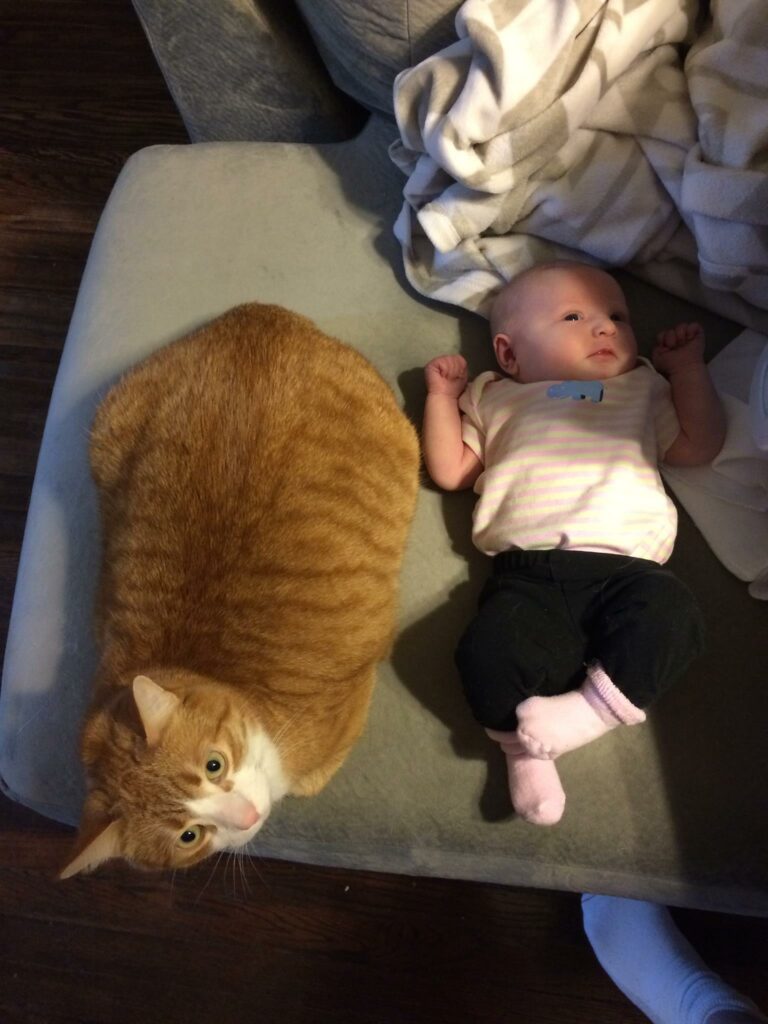This post may contain affiliate links. This means I may receive a small commission if products are purchased through them. All opinions are honest and remain my own.
If you have a little one on the way or a newly mobile baby with cats, you’re going to want to learn how to baby proof your litter box.
I’ll never forget the day I walked in on my 9-month-old eating cat litter out of the box. She had just recently learned to walk and was getting pretty good at it. I wasn’t used to her just being able to get away from me so fast, and got distracted and let her wander into the other room.

![]()
The horror and thoughts that just race through your head all in an instant! Initially, it’s the disgust reaction, EW!
But then they quickly change to omg, I’m a terrible mom! Is my baby going to catch an incurable disease!? (by the way, she’s totally fine)
We had the litter boxes tucked away in the spare bathroom, but then I realized there was nothing actually preventing my daughter from getting into the room in the first place. I just was not prepared!
This is why you, unlike me, are smart and taking steps to make sure your toddler stays out of the litter box!
Solution #1: Prevent your infant/toddler from going in the room in the first place
This is obviously the easiest thing you can do! Rather than worry about getting a litter box that’s more contained (that your cat very well might not even want to use) simply just prevent them from accessing the room where the litter box is in the first place.
If they can’t get in, they can’t get near the box. Right?
But how do you keep your child out while still allowing the cat to get in freely?
Obviously, depending on the setup and where you keep the litter boxes you will need different solutions. Here are a few…
#1 – Door Latch
This is the easiest, least permanent, and least expensive solution to the problem. There are products out there like this Door Buddy that attach to the door and the door frame, which allows the door to stay open just enough for a cat to wiggle there way in, but will keep your children (and dogs) out.
It’s placed high and out of reach of children.
The downside for this is having to attach and re-attach it EVERY time you enter and exit the room. If it’s an area you use frequently like a bathroom, that might get annoying. And if you live with multiple people and older kids, you’ll have to make sure everyone is always latching it back properly.
This would be more ideal to attach on doors for less used spaces you could mostly designate just for the cats – a closet, extra bathroom, backroom, or even a basement.
#2 – Cat Door
A cat door is another option that might be functionally easier than a latch, but it does involve cutting out a hole in your door to install it, which is a bit more permanent. In this case, to prevent your child from getting in you’d simply have to keep the door shut rather than re-latching something.
This cat door on Amazon is shaped like an adorable cat head!
This is also a fairly inexpensive solution, assuming you already own (or can borrow) the proper tools to install the door.
#3 – Baby gate
The third option for securing entryways is with a baby gate. This is a bit more of an expensive solution, but may be necessary or easier in certain situations.
The trick with using a baby gate is to make sure you install it high enough off the ground your cat can easily get under it.
They have all sorts of baby gate sizes, and even ones that wrap around an entire section of a room. This extra-wide gate will expand to fit openings up to 38.5” across and is incredibly popular.
Solution #2 – get top entry or covered litter box
Getting a litter box that your child can’t as easily get into is another route you can take, although it’s a little less secure since these won’t be totally baby-proof. More or less, it just makes it look less like a sand box to your toddler so (hopefully) they won’t be as tempted to mess with it.
A top entry litter box is very high sided and has a top, with a hole for your cats to jump through. This is nice because it also makes the litter box look a bit less litter-box-y (is that a word?) and your child won’t really be able to get to it as easily. This Modkat top-entry litter box is very sleek looking.
Solution #3 – hide the box
Keeping the box out of sight is another way to keep kids out.Out of sight, out of mind, right?
#1 – Empty cabinet space
This is a really great idea if you have any extra cabinet space (like a bottom kitchen cabinet) that you could convert to a litter box area.
Converting cabinet space to litter box area DIY:
- Install a cat door in the cupboard door
- Clean out inside out cupboard space, line with trash bags or waterproof covering
- Put your cat’s litter box inside
- Secure cabinet door with baby safety latch
Before you do this, you’ll want to make sure there’s enough space inside the cupboard for the litter box (and your cat) to fit!
#2 – Get Litter Box Furniture + baby proofing latches
This is any furniture that is designed to disguise a litter box entirely. You can totally do this yourself with any piece of furniture (just like the cabinet idea) but with any type of free-standing furniture so you can place it anywhere in the house. But they also sell a lot of this stuff premade if you aren’t into that DIY type stuff. Check out my list of hidden litter box furniture options here that would fit cats of ALL sizes.
These are really cool to have even if you aren’t trying to baby-proof, but hey, it’s a great multi-purpose solution for your litter box.
If you do choose this method, just sure you attach one of those baby proof latches to the door so your child won’t be able to open up and get inside.
If you find your baby still trying to crawl through the cat door, keep in places where the baby wouldn’t be able to easily access, and if possible combine it with an option from solution #1.
You can read more ideas on ways to hide cat litter boxes here.
Keep them extra clean with babies and toddlers
It’s actually even more important to keep them clean with very young children around your house because they are much more susceptible to some of the diseases that are carried through cat feces. The reason for this is because their immune systems are still developing, and they’re basically just germ-carrying machines.
Just reading this post about why you shouldn’t keep a litter box in your bedroom will make you never want your child near the litter box again!
The Bottom Line
Cat litter boxes are quite dirty and can carry disease, so you definitely don’t ever want to catch your baby or toddler playing with it like a sand box, or worse, actually eating out of it! Taking the proper steps to discourage them from getting near it, or blocking it off entirely, is the best way to ensure they stay away.
Hopefully one of these methods can work for your home! What do you find the biggest challenge to be when trying to keep your litter boxes baby-proof? Let us know in the comments below!





Leave a Reply